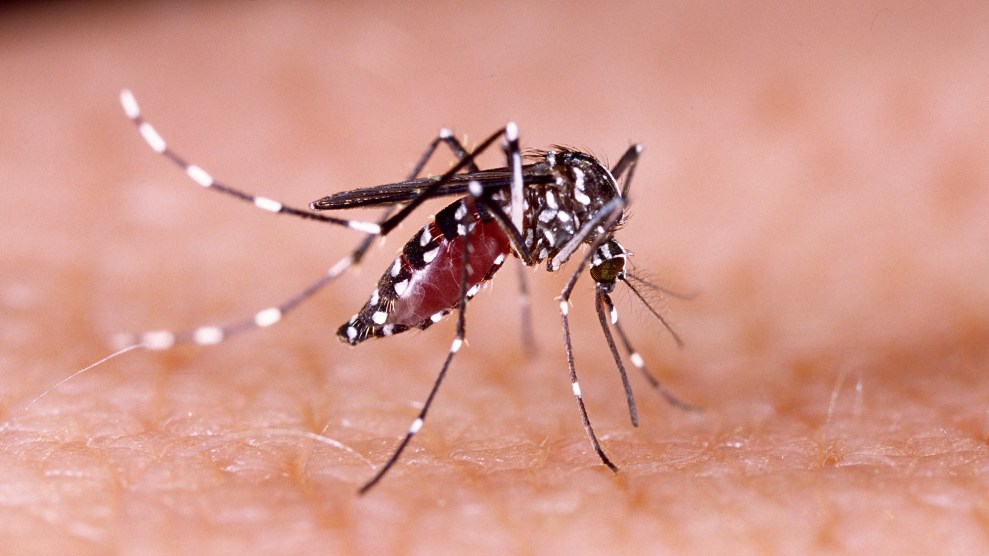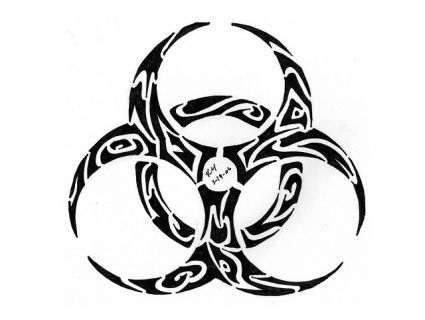
Vladimir Gjorgiev/Shutterstock
On a recent afternoon, in a temperature-controlled room at the University of California-Davis, epidemiologist Chris Barker shows me the life stages of Aedes aegypti, the Zika-carrying mosquito that’s sowing so much panic and confusion. The barely discernable eggs clinging to paper strips. The rice-length larvae, sensitive to light and vibration, wriggling spasmodically in their tanks. The comma-shaped pupae, skittering about in covered baths. And finally, the adults, clinging to the sides of small containers where they feast on sugar water and warm sheep’s blood so the females can nourish their batches of eggs. These particular mosquitoes are not harboring any disease—that would require a high-security biolab—but even this insectary has a screened, air-lock-style foyer and wall-mounted bug zappers with glowing tubes to deal with any fugitives. “Aegypti are not present in nature here” in Northern California, Barker says, “so we certainly don’t want them getting out.”
Nor do our legislators in DC, some of whom have been making frightening statements as they debate how much money to throw at the Zika problem. “We shouldn’t be taking 10 days off as a dangerous virus threatens this nation,” said Harry Reid, the Senate minority leader, rebuking his GOP colleagues recently for leaving for spring recess without passing a Zika bill. “And it is threatening us.”
It’s “a life-threatening issue,” stressed Rep. Joe Crowley (D-NY), and an impending “healthcare catastrophe,” added Rep. Xavier Becerra (D-Calif.). Some Southern Republicans are sounding the alarm, too: “Zika’s shadow is spreading too quickly in Florida,” said Vern Buchanan, the first GOP senator to support the White House’s full $1.9 billion funding request. “The rest of the country should keep in mind that summer is coming and so are the mosquitoes. Congress needs to act quickly.” Erstwhile GOP presidential hopeful and Florida Sen. Marco Rubio piled on as well. “It is just a matter of days, weeks, hours before you will open up a newspaper or turn on the news and it will say that someone in the continental United States was bitten by a mosquito and they contracted Zika,” he said. “When that happens, then everyone is going to be freaked out.”
Rubio is right: This will almost certainly happen at some point, and people will be freaked out. But just how freaked out should we be? To answer that question, and find some perspective on our collective Zika fears, I took a trip out to UC-Davis to meet with Barker and other scientists who actually study mosquitoes and the nasty diseases they carry.
We’ve actually known about Zika for a long time—it was discovered in Africa in 1947 and named after Uganda’s Zika Forest. The biology of the mosquito that’s spreading it is pretty well understood. “Aegypti is the lab rat of the mosquito world,” explains Barker, who also manages California’s surveillance lab for mosquito-borne viruses. Yet until recently, we didn’t worry much about Zika, because outbreaks were rare and the virus seemed pretty benign. Eighty percent of infected people never get sick at all, and for most of the 20 percent who do, it’s not too bad. “Zika is a relatively mild disease—fever, aches, pains, rash, conjunctivitis, and done,” Dr. Anthony Fauci, director of the National Institute of Allergy and Infectious Diseases, who is overseeing vaccine efforts in the United States, told me recently.
But last year, as a Zika outbreak took off in Brazil and spread rapidly across South and Central America, doctors began seeing an unusual number of microcephaly cases—babies born with tiny heads and often severe brain damage. Microcephaly is caused by other things, too, but it’s rare, and Zika seemed like an obvious suspect. Subsequent experiments yielded alarming revelations about how the virus might be gutting the brains of infants. And the bad news kept coming: “First it was, ‘Is it really causally associated with the congenital abnormalities of microcephaly?'” Fauci said, “Then all of a sudden we definitely know: The first cohort study showed a 29 percent incidence, which is really very high. Then we find out the virus destroys neurological tissue very aggressively. Now, if you ever wanted to compound and confound the spread of an outbreak that already is amazingly strange—the first mosquito-borne virus that results in a congenital abnormality—then you find out it’s sexually transmitted!!”
It didn’t stop there. Scientists have now linked Zika to an increase in Guillain-Barré syndrome, a rare condition in which the protein sheath that insulates nerve cells and ensures proper brain function gets eaten away. After learning of this new wrinkle, Fauci recalled, “I was saying, ‘My goodness. Every time you wake up, there’s something else that’s bad about it.'”
As of May 25, according to the Centers for Disease Control and Prevention, we’ve had 591 confirmed Zika cases in the United States, nearly all of them people bitten by mosquitoes while traveling in Zika-afflicted regions. New York had the most cases (127), followed by Florida (121), California (44), Texas (36), and Pennsylvania (19). Only one case is associated with Guillain-Barré. Eleven of them were from having sex with a person who’d been sick with Zika. The CDC notes that 168 pregnant women have either tested positive for the virus itself or harbor antibodies against it—which means they were exposed at some point, but not necessarily while pregnant. Notably, none of the cases resulted from someone being bitten by domestic mosquitoes.
There’s much we still don’t know about Zika. For instance, we don’t know how high the risk of Guillain-Barré might be in those infected, or how the virus causes it. There’s some evidence that Zika may stimulate an immune response that prompts the body to attack its own brain cells. (If true, that could present complications for vaccine developers, since you obviously don’t want to make a shot that produces such a response.)
We also haven’t determined whether the fetus is at risk if a pregnant woman is infected with Zika but shows no symptoms. Or whether an asymptomatic person can transmit the virus through sex. “So far, the only sexual transmissions that we know of are people who transmitted it when they were symptomatic or very soon after,” says Fauci, who has research teams looking into both questions. “In fact, the ones that are well documented had a rash when they transmitted it. But that’s maybe just the tip of the iceberg.”
Before heading out to meet Barker and the others, I hopped on the phone for a little Mosquito 101 with Bill Reisen, a veteran UC-Davis mosquito guy and editor of the Journal of Medical Entomology.
Most of the world’s roughly 3,500 known mosquito species, Reisen points out, are pretty meaningless to us humans. And they’re not much interested in us, either. Most mosquitoes are fairly host-specific—consider the genus Uranotaenia, which bites only frogs. Here in the United States, we’re only concerned with the fewer than 10 species that share our habitat, suck our blood, and can spread human diseases. The mosquito of the hour, the one whose life cycles Barker showed me, is capable of transmitting not only Zika, but the related viruses that cause yellow fever, Chikungunya, and dengue fever.
Why would so few species cause problems, yet one be responsible for so many? Well, some mosquitoes are simply better suited as carriers. Biologically speaking, a lot has to happen within their brief life span—a few weeks for aegypti—for a virus to cycle through the insect and into its saliva. (When the female mosquito sticks its proboscis through a person’s skin, some of that saliva gets transferred into our blood.) With malaria, which once was a big problem in the United States, the process is even trickier. “The mosquito must ingest both male and female parasites, which mate in the mosquito and then form a stage that burrows through the gut wall,” Reisen says. “It’s a marvel it works at all.”
UC-Davis virologist Lark Coffey told me that even at the peak of West Nile—a virus that has killed about 1,900 Americans since 2000 and is primarily spread in the United States by mosquitoes of the Culex genus—less than 1 percent of the insects carried the infection. But when zillions are hatching, that’s enough to cause outbreaks. “It’s a numbers game,” Reisen says.
Aedes aegypti is doing pretty well for itself, numbers-wise, around the world. And the mosquito is not, as Sen. Buchanan put it, “coming”—it’s here. Aegypti is well established along the southern border, particularly in the Gulf states, and in recent years it has become entrenched in the greater Los Angeles area. Its cousin Aedes albopictus—which can transmit all the same viruses, albeit less competently—shares and expands upon that turf. On the East Coast, albopictus can range as far north as New England.
These are not native species. Aegypti is an African mosquito that first caught a lift to the New World on slave ships, according to Reisen. Both aegypti and albopictus (a.k.a. the Asian Tiger Mosquito), have continued to spread around the globe via cargo vessels, often hitching a ride in used tires—an ideal breeding spot. Some 15 years ago, albopictus began repopulating Los Angeles, where scientists thought it had been all but eradicated by conventional control methods—insecticides and so forth. “The way they were getting in was this plant,” Barker says, pulling out a small container of Lucky Bamboo, an Asian import shipped in water. “That’s a lovely way to send mosquitoes around the world.” The tricky devils even can get around by slipping into a car and popping out somewhere else—we’re their chauffeurs.
Aedes aegypti has proven particularly hard to stamp out. Unlike the malaria mosquitoes that breed in marshes and other bodies of water where they are fairly easy targets for insecticides and such, aegypti has evolved to thrive in urban areas. In the United States, it’s a backyard-dweller, laying eggs in lawn drains, construction rubble, trash, those little saucers we place under flowerpots—it will happily breed in the filthiest of conditions, Coffey says. The mosquito bites night and day, feeds almost exclusively on people, and has even picked up an odorant receptor gene that makes us humans an especially attractive target.
The hard part is finding them. Truck-mounted neighborhood spraying of insecticides, which keeps some mosquitoes under control, doesn’t penetrate aegypti habitats. You have to go onto people’s properties, and that requires cooperation from renters and homeowners. “You would go to a very nicely landscaped home, and they’ve got endless flowerpots with little cups on the bottom and sprinklers hitting the pots, so these were constantly wet. You’ve got birdbaths and people with rain barrels, saving water,” says Reisen, who has done door-to-door mosquito surveys in Los Angeles. “You go from that pristine environment to people who are hoarders and have endless garbage in their backyards. You find commodes, wheelbarrows full of water.” Next stop: “Homes with Jacuzzis and swimming pools that are no longer maintained, and they’re just a filthy mess full of mosquitoes.”
Multiply that by the “something like 5 million parcels” under the jurisdiction of the greater Los Angeles vector control district,” Reisen says. Even if you had the manpower to clean up those properties, you’d need the homeowners to keep them clean. Otherwise, “six months later, you’ve got the same problem you started with—it’s just endless.”
A massive effort during the 1960s nearly eliminated aegypti from multiple countries in South and Central America, “but it required huge, almost military-type campaigns of going door to door, as well as the use of the new miracle, DDT,” Reisen says. In a 2001 New Yorker profile, Malcolm Gladwell described the man in charge, Fred Soper, as “the General Patton of entomology,” who “seemed equally capable of browbeating man or mosquito.” But Soper’s tyrannical campaigns came to an end, and now, Reisen says, “we’re back probably worse than we were before.”
We’re worse off, in part, because mosquitoes manage to evolve their way around just about every chemical we throw at them—including the most effective pesticide, DDT—now banned in the United States and many other countries because of its effects on wildlife. In his office at UC-Davis, geneticist Greg Lanzaro shows me how the African malaria mosquito Anopheles coluzzii interbred with rival species Anopheles gambiae, and in the process obtained a gambiae gene that bolsters its defenses against the insecticides used on protective bed nets. “That’s the kind of genetic trickery these mosquitoes are capable of,” Lanzaro says. As for California mosquitoes, Reisen adds, they basically laugh off many of the organochlorides, organophosphates, and pyrethroid compounds in our chemical arsenal. For insect populations, the adage that what doesn’t kill you makes you stronger is particularly apt.
This is some scary stuff, right? And yet, we’ve not seen any Zika transmission by mosquitoes in the United States. To hear the politicians talk, you’d think aegypti are preparing to swarm across the border from points south—tiny illegal immigrants harboring deadly diseases. In reality, the typical aegypti mosquito probably flies only a few hundred meters in its lifetime, Coffey says. A local outbreak would have to begin with a local mosquito biting a Zika-infected traveler and then passing the virus to someone else. And this will probably happen, Fauci told me, because we see it happen with Chikungunya and dengue.
Then again, when was the last time you worried about Chikungunya or dengue—or malaria, for that matter? Those diseases are far scarier than Zika. WHO estimates (conservatively) that malaria infected at least 214 million people last year and killed 438,000, mostly children under five. Then there’s dengue, named from the Swahili phrase ki denga pepo (“a sudden overtaking by a spirit”)—which tells you something about how painful it is. Each year, dengue, also called “breakbone fever,” infects 50-100 million people, sickens about 70 percent of them—half a million very severely—and kills tens of thousands. Brazil, in addition to its Zika problem, is experiencing a record dengue epidemic. Health authorities there tallied 1.6 million cases and 863 deaths last year—and the 2016 toll is on track to be worse. Zika is seldom fatal.
In the United States, over the past six decades, we’ve had 63 small malaria outbreaks caused by local mosquitoes biting stricken travelers and passing the parasite along. The first locally acquired Chikungunya case popped up in Florida in 2014. Our most recent dengue outbreak—in which only a few infections were locally acquired (presumably by mosquitoes)—occurred in Brownsville, Texas, more than a decade ago. These outbreaks have been small and seldom in part because Americans in the South spend a lot of their time in screened, air-conditioned spaces, which minimizes contact with the mosquitoes. (The advent of television is credited as a factor in the decline of malaria in the United States.) Also, compared with the countries that have a lot of infections, American public-health authorities are pretty adept at spotting outbreaks and quashing them before they get out of control.
Only one of the six scientists I interviewed was concerned that Zika might take off in the continental United States. “You would never see Zika virus, Chikungunya virus, or dengue virus sweep across the country the way West Nile did, even in the regions where these mosquitoes are,” Barker told me. “Because that’s just not how it works in our country.”
West Nile is different, because the Culex mosquitoes that spread it also bite birds, which serve as a permanent reservoir for new mosquitoes to be infected with the virus. But health officials kept the dengue and Chikungunya outbreaks in check by using aggressive mosquito control, and by convincing locals to apply repellent, stay indoors with air conditioning, and eliminate standing water from their properties. “So even though I never say never,” Fauci says, “I do not think we are going to have a widespread Zika outbreak in this country.”
It will be a few years, at least, before a vaccine is widely available. In the meantime, the only way Americans are likely to get Zika is by traveling in a Zika zone. If you’re pregnant, or planning on it, you’d be wise to stay far away, and use protection if you’re sleeping with someone who’s been on Zika turf recently. Americans heading to the Olympics in Rio—which has Brazil’s highest infection rates—can protect themselves with long pants, long sleeves, and plenty of DEET.
In the near term, Coffey says, eliminating aegypti is going to be “untenable.” Until we come up with a cutting-edge genetic fix, the holy grail, she says, is an effective single-dose vaccine: “All you ever have to do is see a person once.” The mosquitoes? They’re forever.
















